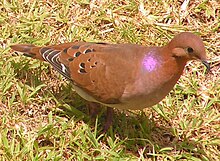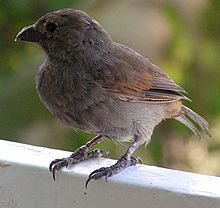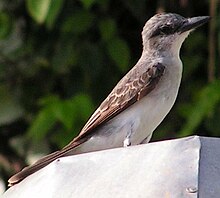Fauna of Barbados
ThefaunaofBarbadoscomprises all theanimalspeciesinhabiting the island of Barbados and its surrounding waters. Barbados has morebiodiversitythan the other Antilles.[1]Human activities are responsible for the change in the composition of the fauna, in particular, the replacement of native species. Species that are able to adapt to human presence have survived.

Origin of Barbadian Fauna
[edit]
The island of Barbados was formed bytectonic upliftand is younger than the surroundinglesser Antilleanislands, primarily of volcanic origin.Aviancolonization has therefore occurred recently relative to the geological age of the island, accounting in part for the lack ofendemic speciesrelative to neighboring islands.[2]
Species capable of crossing the sea barrier by flight enjoyed a comparative advantage, helping to explain why avian species are more numerous than other animal groups, such as mammals. In addition to the natural colonization of the island by animals, humans have contributed to the faunal composition of the island through species introductions (intentional and accidental).[3]
Mammals
[edit]
Fewmammalslive on the island, composed almost entirely of introduced species.[3]TheNorway rat(Rattus norvegicus),house mouse(Mus musculus),European hare(Lepus europaeus),small Indian mongoose(Urva auropunctata), andgreen monkey(Cercopithecus aethiops sabaeus) are the most notable examples.Pigswere introduced by thePortuguesein 1563 as a future food source; the introduction was successful and a feral pig population persisted up until the point ofBritishsettlement of the island, after which they became extirpated.[4]
The nowextinctBarbados raccoon(Procyon lotor gloveralleni) is considered to have been endemic to the island; however, even thissubspeciesmay have been introduced byAmerindiansin prehistoric times.[3][5]An extinct species ofrice ratMegalomys georginaewas described in 2012 based on subfossil remains recovered from an Amerindian archaeological site.[6]
The only remaining native mammals are a number ofbatspecies;[7]the most common of which is thevelvety free-tailed bat(Molossus molossus),[7]which emerges at dusk to feed oninsects.
A breed ofsheepknown as theBarbados Blackbelly sheeporiginated in Barbados. It has been exported to various nations around the world, including theUnited Stateswhere it is sometimes called affectionately "Barbado Sheep".
Marine mammalsare not frequently seen in Barbadian waters. Some species, however, particularlybottlenose dolphins(Tursiops truncatus) andhumpback whales(Megaptera novaeangliae), are occasionally seen offshore on the north coast.[4]
Feral dogsandcats,introduced by humans, are also present on the island.
Birds
[edit]
Birdsare fairly well represented on the island, with most having adapted well to the presence of humans.
Twoextinctspecies have been described from theLate Pleistoceneof Barbados, the gooseNeochen barbadianaand theBarbados railFulica podagrica,although the classification of the rail is questionable.[8][9]
Early European visitors also reported finding a species of parrot on the island,[10]which subsequently became extinct. Currently, parrots are represented by a few escaped or released individuals which have formed feral populations; most notable is a small population of theorange-winged parrot(Amazona amazonica) which has become established among severalRoystoneapalms in the Belleville district of the capitalBridgetown.[11]Thebrown-throated parakeet(Aratinga pertinax), introduced to the island, is rarely seen.
The endemic subspecies of thescaly-breasted thrasher(Allenia fusca atlantica) may have become extirpated from the Island. A resident race of theyellow warbler(Dendroica petechia petechia) is also threatened, mostly due to loss of itsmangrove swamphabitat;[12]the last major refuge for this species is theGraeme Hall Swampin the south of the Island,[13]However some reports suggest the species is expanding its range on the island.[11]
Icteridssuch as theCarib grackle(Quiscalus lugubris) and theshiny cowbird(Molothrus bonariensis), which often parasitizes the nests of the former species, are quite common.
Seedeatersinclude theblack-faced grassquit(Tiaris bicolor) and thegrassland yellow finch(Sicalis luteola), known locally as thegrass canary.Introduced from South America the grassland yellow finch is now faced with extirpation due to poaching for the pet trade. Until recently considered a non-sexually dimorphic subspecies of theLesser Antillean bullfinch(Loxigilla noctis), theBarbados bullfinch(Loxigilla barbadensis) has recently been elevated to species level, and is the only extant endemic bird species on Barbados.[14]
There are two species oftyrant flycatcherfound on the island; thegrey kingbird(Tyrannus dominicensis) which is quite common, and theCaribbean elaenia(Elaenia martinica) which is rarer.
Representatives of the familyColumbidaeinclude thezenaida dove(Zenaida aurita),common ground dove(Columbina passerina),scaly-naped pigeon(Patagioenas squamosa), and the ubiquitousrock pigeon(Columba livia). Another species, theeared dove(Zenaida auriculata), which was previously reported as an occasional visitor to the island, has now established a breeding population.[15]
Nectar consuming species include theAntillean crested hummingbird(Orthorhyncus cristatus),green-throated carib(Eulampis holosericeus), and thebananaquit(Coereba flaveola).
Heronspecies include, thecattle egret(Bubulcus ibis) and the fairly raregreen heron(Butorides virescens). A recent addition to the island'savifaunais thelittle egret(Egretta garzetta), which has recently colonized the island fromAfrica.[15]

Species that may be encountered inwetlandareas include themasked duck(Nomonyx dominica),American coot(Fulica americana), and thecommon moorhen(Gallinula chloropus)[13] Thesouthern lapwing(Vanellus chilensis), ashorebird,has recently bred upon the island; having spread to Barbados fromTrinidad and Tobagoand northernSouth America.[16]
Substantial numbers ofmigratory birdseither over-wintering on the island, or en route from North America to South American wintering grounds are seen annually.[3]Shorebirds are one such group of birds that stop off in Barbados during migration; tens of thousands, however, lured to artificial wetlands, are shot annually for sport.[17]
Reptiles and Amphibians
[edit]
Thegreen iguana(Iguana iguana) formerly resided on the island before being extirpated. An endemic species ofanolelizard (Anolis extremus), and the introducedtropical house gecko(Hemidactylus mabouia) are both common species; whileUnderwood's spectacled tegu(Gymnophthalmus underwoodi), and a native species ofKentropyxlizard (Kentropyx borckiana) are rarer on the island.[18]The endemicBarbados leaf-toed gecko(Phyllodactylus pulcher) was thought to be extinct until a population was rediscovered in 2011 on the outcrop known asCulpepper Island.[19]
Populations of an endemicLiophisgrass snake, theBarbados racer(Erythrolamprus perfuscus), have been devastated as a result of predation by the introduced Indian mongoose, with no confirmed sightings of the species since 1961. Another snake species,Mastigodryas bruesiand the world's smallest snake,Leptotyphlops carlae,have also been recorded from the island.[3]
Thered-footed tortoise(Geochelone carbonaria) is widely kept in captivity; it was likely introduced to the island, as no reports of it were made by early European explorers to the island.[3]

Currently there are two species ofsea turtlewhich nest in Barbados, thehawksbill turtle(Eretmochelys imbricata), and theleatherback turtle(Dermochelys coriacea). Though not nesting on the island, thegreen sea turtle(Chelonia mydas) does forage in nearshoreseagrassbeds. Coastal infrastructure, such as hotel properties, has encroached upon the nesting grounds of sea turtles, while coastal lights also detrimentally impact nesting females.
Thecane toad(Bufo marinus) from South America and theJohnstone's whistling frog(Eleutherodactylus johnstonei) encompass the islands'amphibiancommunity.[20]The introduction of the cane toad was done as a biological control aimed at insect pests ofsugarcane;[3]as has been the case elsewhere, the lack of predators to control the cane toad has led to uncontrolled populations in some areas.
Fish
[edit]Freshwater Fish
[edit]
The wild form of theguppy(Poecilia reticulata) is native to Barbados as well asTrinidadand northern South America.[21]Introductions of aquarium varieties of the guppy into the wild mean that it may be impossible to distinguish between original and fancy varieties.[citation needed]
Originally intended foraquaculture,tilapiaspecies including,Oreochromis mossambicus,[22]andTilapia zilliihave become widely established in ponds and streams across the island.[13][23]
Brackish Water Fish
[edit]Brackish waterspecies also occur, particularly in coastal wetlands such as the Graeme Hall Swamp; one such species is themangrove rivulus(Rivulus marmoratus),[13]notable for its unique ability of self-fertilization.[24] A resident and isolated population ofAtlantic tarpon,(Megalops atlanticus) has become established in the Graeme Hall Swamp.[13]

Invertebrates
[edit]Crustaceans
[edit]Terrestrialcrabspecies found on the island includeCardisoma guanhumiandGecarcinus lateralis.[25]
References
[edit]- ^"The Search is on for the Rare Barbados Threadsnake in Nature Documentary on Barbados' Biodiversity | Biodiversity Barbados".Retrieved2023-03-14.
- ^Lovette, Irby J.; Seutin, Gilles; Ricklefs, Robert E.; Bermingham, Eldredge (March 1999), "The assembly of an island fauna by natural invasion: Sources and temporal patterns in the avian colonization of Barbados",Biological Invasions,1(1): 33–41,doi:10.1023/A:1010090414598,S2CID3259633
- ^abcdefgGovernment of Barbados (2002),A National Biodiversity Strategy & Action Plan For Barbados: To the Convention on Biological Diversity (CBD),archived fromthe originalon September 28, 2007,retrieved2007-09-04
- ^abCreswell, Joel,Marine Mammals in Barbados,archived fromthe originalon 2007-04-19,retrieved2007-09-04
- ^Timm, R.; Cuarón, A.D.; Reid, F.; Helgen, K. & González-Maya, J.F. (2016)."Procyon lotor".IUCN Red List of Threatened Species.2016:e.T41686A45216638.doi:10.2305/IUCN.UK.2016-1.RLTS.T41686A45216638.en.Retrieved7 January2024.
- ^Turvey, ST; Brace, Selina; Weksler, Marcio (2012). "A new species of recently extinct rice rat (Megalomys) from Barbados ".Mammalian Biology.70(2012): 404–413.doi:10.1016/j.mambio.2012.03.005.
- ^abCorrie, Damon,First Nations Vacations - About Barbados,archived fromthe originalon 2007-09-28,retrieved2007-09-04
- ^Brodkorb, P. (1965) Fossil birds from Barbados, West Indies.The Journal of the Barbados Museum and Historical Society31(1): 3-10.
- ^Olson, S. (1977) A synopsis on the fossil Rallidae In: S. Dillon RipleyRails of the World - A Monograph of the Family Rallidae.Codline. Boston.ISBN0-87474-804-6
- ^Clark, Austin H. (1905),"The West Indian Parrots"(PDF),The Auk,XXII(1): 337–344,doi:10.2307/4069996,JSTOR4069996,retrieved2007-09-05
- ^abCaribzones,Barbados birdwatching,retrieved2007-09-05
- ^Bachynski, K.; Kadlec, M. (2003),"Dendroica petechia" (On-line), Animal Diversity Web,retrieved2007-09-05
- ^abcdeGraeme Hall Nature Sanctuary,graemehall.com,retrieved2007-09-05
- ^Birdlife International,What's new (2007),archived fromthe originalon 2007-08-28,retrieved2007-09-05
- ^abMassiah, Edward,Birding Facts Birding Resources by the Fat Birder,retrieved2007-09-05
- ^Wilson, Julie (2007-07-16),Watson: Bird hunting a concern,The Daily Telegraph, archived fromthe originalon 2007-09-27,retrieved2007-09-04
- ^Shemilt, Michael (2007-08-21),Killing fields of Barbados,The Daily Telegraph,retrieved2007-09-03[dead link]
- ^Corrie, Damon,Barbados Reptiles and Amphibians,archived fromthe originalon September 29, 2007,retrieved2007-09-05
- ^"Once presumed extinct Barbados Leaf-Toed Gecko (Phyllodactylus pulcher) re-discovered in Barbados!".5 October 2011.
- ^The Caribbean Herpetological Society,Reptiles and Amphibians of Barbados West Indies(PDF),archived fromthe original(PDF)on June 28, 2007,retrieved2007-09-05
- ^zipcodezoo,Poecilia reticulata,archived fromthe originalon September 30, 2007,retrieved2007-09-05
- ^Barbados National Assessment Report (NAR) on The Implementation Of The Barbados Programme Of Action (BPOA), 2004, Section 5.1,archived fromthe originalon 2008-12-17,retrieved2007-11-09
- ^Tilapia and the Environment,retrieved2007-09-05
- ^Parker, Christoph; Oxenford, Hazel A.,Environment and development in coastal regions and in small islands,retrieved2007-09-05
- ^Harris, RR (1977),"Urine production rate and water balance in the terrestrial crabsGecarcinus lateralisandCardisoma guanhumi"(PDF),The Journal of Experimental Biology,68:57–67,doi:10.1242/jeb.68.1.57,PMID894187,S2CID23339990
